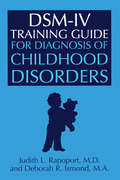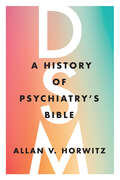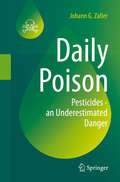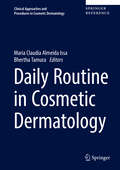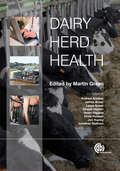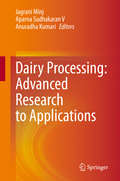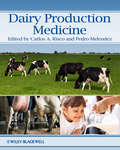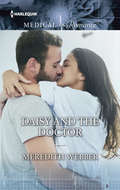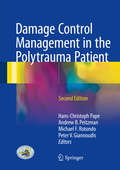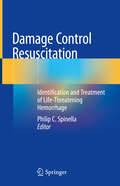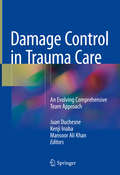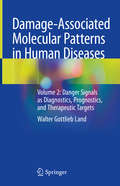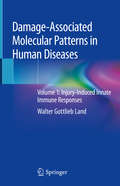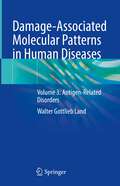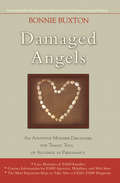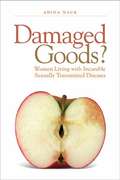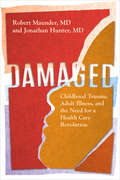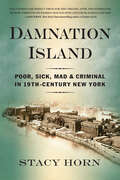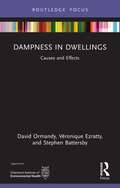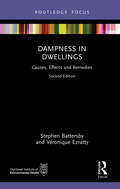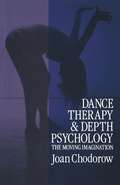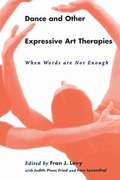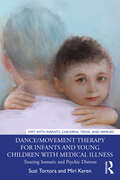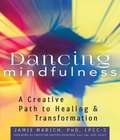- Table View
- List View
DSM-IV Training Guide For Diagnosis Of Childhood Disorders
by Judith L. Rapoport Deborah R. IsmondFirst published in 1996. Routledge is an imprint of Taylor & Francis, an informa company.
DSM-IV-TR Casebook
by Michael B. First Andrew E. Skodol Janet B. W. Williams Robert L. SpitzerThis casebook for students, clinicians, and related professionals presents a selection of real clinical vignettes which illustrate the concepts and terminology found in the DSM-IV-TR. These accounts have been edited to focus on information relevant to differential diagnosis. The cases are organized into sections on adults, children and adolescents, multiaxial assessment, international cases, and historical cases. They are also indexed by diagnosis and by special interest (i.e. in the medical setting). Each case is followed by a discussion of the DSM-IV-TR differential diagnosis. The editors are with the psychiatry department at Columbia University. Annotation c. Book News, Inc., Portland, OR (booknews.com)
DSM: A History of Psychiatry's Bible
by Allan V. HorwitzThe first comprehensive history of "psychiatry's bible"—the Diagnostic and Statistical Manual of Mental Disorders.Over the past seventy years, the Diagnostic and Statistical Manual of Mental Disorders, or DSM, has evolved from a virtually unknown and little-used pamphlet to an imposing and comprehensive compendium of mental disorder. Its nearly 300 conditions have become the touchstones for the diagnoses that patients receive, students are taught, researchers study, insurers reimburse, and drug companies promote. Although the manual is portrayed as an authoritative corpus of psychiatric knowledge, it is a product of intense political conflicts, dissension, and factionalism. The manual results from struggles among psychiatric researchers and clinicians, different mental health professions, and a variety of patient, familial, feminist, gay, and veterans' interest groups. The DSM is fundamentally a social document that both reflects and shapes the professional, economic, and cultural forces associated with its use.In DSM, Allan V. Horwitz examines how the manual, known colloquially as "psychiatry's bible," has been at the center of thinking about mental health in the United States since its original publication in 1952. The first book to examine its entire history, this volume draws on both archival sources and the literature on modern psychiatry to show how the history of the DSM is more a story of the growing social importance of psychiatric diagnoses than of increasing knowledge about the nature of mental disorder. Despite attempts to replace it, Horwitz argues that the DSM persists because its diagnostic entities are closely intertwined with too many interests that benefit from them. This comprehensive treatment should appeal to not only specialists but also anyone who is interested in how diagnoses of mental illness have evolved over the past seven decades—from unwanted and often imposed labels to resources that lead to valued mental health treatments and social services.
Daily Poison: Pesticides - an Underestimated Danger
by Johann G. ZallerThis book is a sound science report about the consequences of pesticides to nature, health and environment.The book shares essential insights into the use of pesticides in agriculture, discusses the politics, rhetoric and profits involved, addresses the potential health and ecological risks of pesticides in our daily lives, and debates possible solutions. Does sustainable agriculture exist, and is agriculture without pesticides possible at all?Moreover, the author gives insight into his scientific work, the set-up of the experiments, and also writes about his very own experiences with the media and press after publication of his studies.For many years, Johann G. Zaller, an ecologist at the University of Natural Resources and Life Sciences in Vienna, and his team, have been researching applied chemicals and their effects on the environment. Their findings, together with relevant literature and media reports, are presented in this book, which offers a unique resource for anyone who wants to know the nature and background of pesticides and how we come into contact with them in our daily lives. Ever ate an apple? Read this book!
Daily Routine in Cosmetic Dermatology (Clinical Approaches and Procedures in Cosmetic Dermatology #1)
by Maria Claudia Almeida Issa Bhertha TamuraThe series "Clinical Approaches and Procedures in Cosmetic Dermatology" intends to be a practical guide in Cosmetic Dermatology. Procedures in cosmetic dermatology are very popular and useful in medicine, indicated to complement topical and oral treatments not only for photodamaged skin but also for other dermatosis such as acne, rosacea, scars, etc. Also, full-face treatments using peelings, lasers, fillers and toxins are increasingly being used, successfully substituting or postponing the need for plastic surgeries. Altogether, these techniques not only provide immediate results but also help patients to sustain long-term benefits, both preventing/treating dermatological diseases and maintaining a healthy and youthful skin. Throughout this series, different treatments in Cosmetic Dermatology will be discussed in detail covering the use of many pharmacological groups of cosmeceuticals, the new advances in nutraceuticals and emerging technologies and procedures. This volume, entitled "Daily Routine in Cosmetic Dermatology" will be an important tool for aesthetic doctors, practicing dermatologists, plastic surgeons, and all other physicians interested in the field of aesthetic medicine. It discloses in detail the semiology and general treatments in cosmetic dermatology, providing the state-of-the-art regarding patients' evaluation, photoprotection, nutraceuticals and cosmeceuticals and special prescriptions. Also check the other volumes: Volume II - Chemical and Physical Peelings Volume III - Lasers, Lights and Other Technologies Volume IV - Botulinum Toxins, Fillers and Related Substances
Dairy Herd Health
by Martin Green Chris Hudson Helen Higgins Paula Wilson James Breen Andrew Bradley Jonathan Statham Alastair Hayton Laura Green Mike Thorne Wendela Wapenaar Mark Burnell Andrew Biggs Jon Huxley Bill May Jonathan ReaderDairy herd health is an important and universal topic in large animal veterinary practice and farming, covering both preventive medicine and health promotion. With the move towards large-scale farming, the health of the herd is important as an economic unit and to promote the health of the individuals within it. This book focuses on diseases within herds, herd husbandry practices, youngstock management and environmental issues. Major diseases and conditions are covered, including mastitis, lameness, nutrition, metabolic and common infectious diseases from a herd health perspective. It is an essential resource for veterinary practitioners and students, researchers and dairy industry personnel.
Dairy Processing: Advanced Research to Applications
by Jagrani Minj Aparna Sudhakaran V Anuradha KumariThis book focuses on advanced research and technologies in dairy processing, one of the most important branches of the food industry. It addresses various topics, ranging from the basics of dairy technology to the opportunities and challenges in the industry. Following an introduction to dairy processing, the book takes readers through various aspects of dairy engineering, such as dairy-based peptides, novel milk products and bio-fortification. It also describes the essential role of microorganisms in the industry and ways to detect them, as well as the use of prebiotics, and food safety. Lastly, the book examines the challenges faced, especially in terms of maintaining quality across the supply chain. Covering all significant areas of dairy science and processing, this interesting and informative book is a valuable resource for post-graduate students, research scholars and industry experts.
Dairy Production Medicine
by Carlos A. Risco Pedro Melendez RetamalThis comprehensive book integrates new technology and concepts that have been developed in recent years to manage dairy farms in a profitable manner. The approach to the production of livestock and quality milk is multidisciplinary, involving nutrition, reproduction, clinical medicine, genetics, pathology, epidemiology, human resource management and economics. The book is structured by the production cycle of the dairy cow covering critical points in cow management. Written and edited by highly respected experts, this book provides a thoroughly modern and up-to-date resource for all those involved in the dairy industry.
Daisy and the Doctor
by Meredith WebberDr. Julian Austin doesn't believe in love. Psychologist Daisy just doesn't trust it — she's been hurt too often.Yet they both want a family…so a simple, affectionate partnership promises to be the ideal solution.The doctor and the psychologist are a perfect match. Until Daisy realizes that, for her, marriage to Julian would be exactly the love match she was hoping to avoid. And Julian starts to wonder — if love doesn't exist, then what's happening to his heart?
Damage Control Management in the Polytrauma Patient
by Peter V. Giannoudis Hans-Christoph Pape Andrew B. Peitzman Michael F. RotondoThis book is an unparalleled source of cutting-edge information on every aspect of rescue, trauma management, and fracture care in the polytrauma/multiple injured patient. Damage control surgery is approached logically and systematically by dividing treatment into phases. The common goal of treating life-threatening conditions first, then treating major pelvic and extremity fractures, requires cooperation among all major disciplines and subspecialties involved in the care of polytrauma patients, and the book is accordingly multidisciplinary in nature. It is edited by pioneers in the field and the authors are all acclaimed experts. This second, revised and updated edition of Damage Control Management in the Polytrauma Patient will be invaluable for all clinicians who must weigh life-saving operations against limb-threatening conditions, including emergency personnel, trauma surgeons, orthopaedic traumatologists, and anesthesiologists.
Damage Control Resuscitation: Identification and Treatment of Life-Threatening Hemorrhage
by Philip C. SpinellaThis book provides a comprehensive overview of damage control resuscitation (DCR), an evidence-based approach to the resuscitation of patients with severe life-threatening hemorrhage (LTH). It focuses on both civilian and military applications as DCR is utilized in civilian trauma situations as well as combat casualty care settings. The book covers the history of fluid resuscitation for bleeding, epidemiology of severe traumatic injuries, prediction of life-threatening hemorrhage, pathophysiology and diagnosis of blood failure, and permissive hypotension. Chapters provide in-depth detail on hemostatic resuscitation principles, dried plasma, dried platelet surrogates, and recent developments in frozen red blood cells and oxygen carriers. The book also discusses how DCR principles can be used in a variety of situations such as when there are large numbers of patients with hemorrhagic lesions, non-trauma scenarios, and on distinct populations such as children. Finally, it concludes with a discussion of training and education methods for the implementation of DCR and remote DCR principles as well as learning healthcare system principles to facilitate the implementation of DCR and ultimately improve outcomes for patients with life-threatening hemorrhage. Damage Control Resuscitation: Identification and Treatment of Life-Threatening Hemorrhage is an essential resource for physicians and related professionals, residents, nurses and medical students in emergency medicine, anesthesia, surgery, and critical care, as well as civilian and military EMS providers.
Damage Control in Trauma Care: An Evolving Comprehensive Team Approach
by Kenji Inaba Juan Duchesne Mansoor Ali KhanThis book describes current, evidence-based guidelines for damage control interventions across the field of trauma care with the aim of enabling clinicians to apply them to best effect in daily clinical practice. Emphasis is placed on the need for trauma surgeons and their teams to recognize that optimal damage control in severely traumatized patients depends upon the combination of immediate assessment, resuscitation, and correct surgical management. The book opens by examining the evolution of damage control and the very significant impact that military damage control interventions have had on civilian emergency health care through improvements as simple as bandaging and tourniquets. Damage control measures in different specialties, including neurosurgery, orthopedics, vascular surgery, cardiothoracic surgery, anesthesia, and critical care, are then covered in detail. Readers will also find helpful information on a range of other important topics, such as the role of pre-hospital care providers, damage control within the emergency department, adjuncts of damage control, and damage control in austere environments. This book is a ‘must read’ for all clinicians in the trauma field.
Damage-Associated Molecular Patterns in Human Diseases: Volume 2: Danger Signals as Diagnostics, Prognostics, and Therapeutic Targets
by Walter Gottlieb LandThis book is a continuance of the topic: “DAMPs in Human Diseases”, the basics of which were described in a first volume by the same author. This second volume presents our current understanding of the impact of sterile stress/injury-induced innate immune responses on the etiopathogenesis of human diseases by focusing on those diseases that are pathogenetically dominated by DAMPs, i.e., on polytrauma, various solid organ injuries (brain, lung, kidney, liver), atherosclerosis, and cerebro-cardiovascular diseases. Our growing understanding of the pathogenetic function of activating DAMPs and suppressive DAMPs (“SAMPs”) is used as a point of departure to explore how these molecules can be used as biomarkers to extend and improve current diagnostic and prognostic modalities. Moreover, this new knowledge about the pathogenetic function of DAMPs and SAMPs is taken as a sound and plausible reason for discussing their implications for present and future treatment of the diseases addressed here. In this context, the focus is on the potential of DAMPs as future therapeutic targets and SAMPs as future therapeutics, applied in strict compliance with safety precautions, as also recommended in this work. The book is intended for professionals from all medical and paramedical disciplines who are interested in applying innovative data from inflammation and immunity research to clinical practice. The readership will include practitioners and clinicians working in the broad field of acute and chronic inflammatory/fibrotic diseases, in particular, traumatologists and intensivists; neurologists and neurosurgeons; cardiologists and cardiac surgeons; pulmonologists and thoracic surgeons; vascular surgeons; nephrologists; gastroenterologists and hepatologists; and pharmacists. Also available: Damage-Associated Molecular Patterns in Human Diseases - Vol. 1: Injury-Induced Innate Immune Responses
Damage-Associated Molecular Patterns in Human Diseases: Volume 1: Injury-Induced Innate Immune Responses
by Walter Gottlieb LandThis book presents current understanding of the importance of modern immunology in the etiopathogenesis of human diseases and explores how this understanding is impacting on diagnosis, prognosis, treatment, and prophylaxis. As the core of modern immunology, the “danger/injury model” is introduced and addressed throughout the book. Volume I of the book describes the network of damage-associated molecular pattern molecules (DAMPs) and examines the central role of DAMPs in cellular stress responses and associated regulated cell death, the promotion and resolution of inflammation, the activation of innate lymphoid cells and unconventional T cells, the stimulation of adaptive immunity, and tissue repair. The significance of DAMPs in a wide range of human diseases will then be explored in Volume II of the book, with discussion of the implications of injury-induced innate immunity for present and future treatments. This book is written for professionals from all medical and paramedical disciplines who are interested in the introduction of innovative data from immunity and inflammation research into clinical practice. The readership will include practitioners and clinicians such as hematologists, rheumatologists, traumatologists, oncologists, intensive care anesthetists, endocrinologists such as diabetologists, psychiatrists, neurologists, pharmacists, and transplantologists.
Damage-Associated Molecular Patterns in Human Diseases: Volume 3: Antigen-Related Disorders
by Walter Gottlieb LandThe core of this three-volume book deals with damage-associated molecular patterns abbreviated “DAMPs”, which are unique molecules that save life and fight for survival of all organisms on this planet by triggering robust inflammatory/immune defense responses upon any injury, including those caused by pathogens such as viruses and bacteria. However, these molecules also have a dark side: when produced in excess upon severe insults, they can trigger serious human diseases. The three volumes present current understanding of the importance of DAMP-promoted immune responses in the etiopathogenesis of human diseases and explore how this understanding is impacting diagnosis, prognosis, and future treatment. This third volume addresses the potential of DAMPs in clinical practice, as therapeutic targets and therapeutics, by focusing on a description of antigen-related diseases, which are pathogenetically dominated by DAMPs, that is, infectious and autoimmune disorders and allograft rejection (as an undesired function of these molecules), as well as tumor rejection (as the desired function of these molecules). The book is written for professionals from all medical and paramedical disciplines who are interested in the introduction of innovative data from modern inflammation and immunity research into clinical practice. In this sense, the book reflects an approach to translational medicine. The readership will include all practitioners and clinicians, in particular, ICU clinicians, infectiologists, microbiologists, virologists, hematologists, rheumatologists, diabetologists, neurologists, transplantologists, oncologists, and pharmacists. Also available: Damage-Associated Molecular Patterns in Human Diseases - Vol. 1: Injury-Induced Innate Immune Responses; Damage-Associated Molecular Patterns in Human Diseases - Vol. 2: Danger Signals as Diagnostics, Prognostics, and Therapeutic Targets.
Damaged Angels: An Adoptive Mother Discovers the Tragic Toll of Alcohol in Pregnancy
by Bonnie BuxtonPart heartfelt memoir, part practical guide, "Damaged Angels" recounts Bonnie Buxton's struggles to raise an adopted daughter whom she didn't realize was afflicted with fetal alcohol disorder. Her book also offers guidance to parents who have children with FASD. By the time BonnieOCOs daughter Colette hit first grade, her parents were coping with her frequent stealing and lying, and the necessity of special education. At fourteen, she discovered drugs and sex; by eighteen, she was a crack addict living on the streets. After many frustrating years consulting numerous therapists, a TV news story gave Bonnie the answer she was looking for ? and sent her on a quest for a diagnosis and help for Colette. "Damaged Angels" can aid and comfort all those affected by FASD ? the most common cause of intellectual impairments in most industrialized nations ? and reduce the number of babies born with this disorder in the future. The most important book on fetal alcohol disorder since Michael DorrisOCOs "The Broken Cord, Damaged Angels" is a book for every parent, practitioner, and teacher working with a child with FASD. "
Damaged Goods?: Women Living with Incurable Sexually Transmitted Diseases
by Adina NackHow do women living with genital herpes and/or HPV (human papilloma virus) infections see themselves as sexual beings, and what choices do they make about sexual health issues? Adina Nack, a medical sociologist who specializes in sexual health and social psychology, conducted in-depth interviews with 43 women about their identities and sexuality in regards to chronic illness. The result is a fascinating book about an issue that affects over 15 million Americans, but is all too little discussed. Damaged Goods adds to our knowledge of how women are affected by living with chronic STDs and reveals the stages of their sexual- self transformation. From the anxiety of being diagnosed with an STD to issues of blame and shame, Nack-herself diagnosed with a cervical HPV infection-shows why these women feeling that they are "damaged goods," question future relationships, marriage, and their ability to have healthy children.
Damaged: Childhood Trauma, Adult Illness, and the Need for a Health Care Revolution
by Robert Maunder, MD Jonathan Hunter, MDChildhood adversity that is severe enough to be harmful throughout life is one of the biggest public health issues of our time, yet health care systems struggle to even acknowledge the problem. In Damaged, Dr. Robert Maunder and Dr. Jonathan Hunter call for a radical change, arguing that the medical system needs to be not only more compassionate but more effective at recognizing that trauma impacts everybody's health, from patient to practitioner. Drawing on decades of experience providing psychiatric care, Maunder and Hunter offer an open and honest window into the private world of psychotherapy. At the heart of the book is the painful yet inspiring story of Maunder's career-long work with a patient named Isaac. In unfiltered accounts of their therapy sessions, we see the many ways in which childhood trauma harms Isaac's health for the rest of his life. We also see how deeply patients can affect the doctors who care for them, and how the caring collegiality between doctors can significantly improve the medicine they practice. Damaged makes it clear that human relationships are at the core of medicine, and that a revolution in health care must start with the development of safe, respectful, and caring relationships between doctors and patients. It serves as a strong reminder that the way we care for those who suffer most reveals who we are as a society.
Damnation Island: Poor, Sick, Mad, and Criminal in 19th-Century New York
by Stacy Horn<P><P>On a two-mile stretch of land in New York’s East River, a 19th-century horror story was unfolding . . . <P><P>Today we call it Roosevelt Island. Then, it was Blackwell’s, site of a lunatic asylum, two prisons, an almshouse, and a number of hospitals. <P><P>Conceived as the most modern, humane incarceration facility the world ever seen, Blackwell’s Island quickly became, in the words of a visiting Charles Dickens, “a lounging, listless madhouse.” <P><P>In the first contemporary investigative account of Blackwell’s, Stacy Horn tells this chilling narrative through the gripping voices of the island’s inhabitants, as well as the period’s officials, reformers, and journalists, including the celebrated Nellie Bly. <P><P>Digging through city records, newspaper articles, and archival reports, Horn brings this forgotten history alive: there was terrible overcrowding; prisoners were enlisted to care for the insane; punishment was harsh and unfair; and treatment was nonexistent. <P><P>Throughout the book, we return to the extraordinary Reverend William Glenney French as he ministers to Blackwell’s residents, battles the bureaucratic mazes of the Department of Correction and a corrupt City Hall, testifies at salacious trials, and in his diary wonders about man’s inhumanity to man. <P><P>In Damnation Island, Stacy Horn shows us how far we’ve come in caring for the least fortunate among us—and reminds us how much work still remains.
Dampness in Dwellings: Causes and Effects (Routledge Focus on Environmental Health)
by Stephen Battersby David Ormandy Veronique EzrattyThis book provides a definition of dampness in each of its forms, details the various potential sources, and causes that can result in damage to the building, and importantly, the threats to the health of the occupiers. It is practical, providing an outline of the possible solutions looking at aspects of building design and construction that can reduce or avoid the risk of dampness. It also discusses why dampness is a risk to the health of occupiers and so justifies the need to protect health by reducing or removing it. Co-authored by a medical doctor and environmental health practitioners with combined experience of over 50 years, this book includes: Explanations and justifications for why dampness is important, and why remedial action must be taken. Up-to-date information on the causes, effects, and remedies of damp in the housing environments. Dampness in Dwellings is a pivotal resource for professionals in the housing, medical, and legal sectors.
Dampness in Dwellings: Causes, Effects and Remedies (Routledge Focus on Environmental Health)
by Stephen Battersby Véronique EzrattyThis revised and updated book provides a definition of dampness in each of its forms; it details the various potential sources and causes that can result in damage to the building and damage to the health of the occupiers. It is both practical and provides an outline of the possible solutions, looking at aspects of building design and construction that can reduce or avoid the risk of dampness. It also discusses why dampness is a risk to the health of occupiers and so justifies the need to protect health by reducing or removing it.This book: Provides a valuable resource for housing, legal, and medical professionals Discusses possible solutions in aspects of building design and construction that can reduce or avoid the risk of dampness and also the safe removal of mould Provides an explanation of the legal framework in the UK and potential legal remedies for adverse health effects as a result of dampness The new edition of Dampness in Dwellings includes expanded details on the health implications of dampness in the home, legal updates, and new thinking in the wake of the tragic death of Awaab Ishak. It provides a pivotal resource for active professionals in housing, medical, and legal sectors.
Dance Therapy and Depth Psychology: The Moving Imagination
by Joan ChodorowAn historical overview of Jung's basic concepts is given as well as the most recent depth psychological synthesis of affect theory based on the work of Sylvan Tomkins, Louis Stewart, and others. Finally in discussing the use of dance/movement as active imagination in practice, the movement themes that emerge and the non-verbal expressive aspects of the therapaeutic relationship are described.
Dance and Other Expressive Art Therapies: When Words are Not Enough
by Fran J. Levy<p>The field of dance/movement therapy has long awaited a book, such as this one, which gives us detailed clinical material on specific patient populations. Fran Levy's first book, Dance/Movement Therapy: A Healing Art, provided a strong practical, historical, and theoretical foundation on which this book firmly stands. All of the selections that follow have been written by recognized leaders and contributors to the field. <p>Expressed in language that appeals to the heart as well as the mind, the book addresses immediate and pressing clinical concerns. Technical jargon is kept to a minimum, and, when used, is always defined. Throughout the book, the needs of patients are carefully considered and creatively met through the courage and perseverance of each therapist. Thoughtful and sensitive descriptions of the individuals discussed allows for an unusual intimacy between the reader and the patient. The authors believe that the experience of movement, on both symbolic and expressive levels, can transform individuals and guide their journeys to recovery.</p>
Dance/Movement Therapy for Infants and Young Children with Medical Illness: Treating Somatic and Psychic Distress (DMT with Infants, Children, Teens, and Families)
by Suzi Tortora Miri KerenThis book presents dance/movement therapy as a window into the emotional and internal experience of a baby with a medical illness, within the context of treating the whole family system and using the DC 0-5 as the basis for formulating the clinical situation. This book fills a gap in the literature, bringing a variety of fields together including infant mental health, infant and child psychiatry, nonverbal-movement analysis, and the creative arts therapies. Grounded in a biopsychosocial perspective, dance/movement therapy is introduced as the main treatment modality, using nonverbal expression as a means of communication, and dance and music activities as intervention tools, to support the child and family. Vignettes from both during and years after the medical experience are presented throughout the book, taking into consideration the subtle and more obvious effects of illness on the child’s later emotional, social, and behavioral development. They illustrate the expertise of the authors as infant mental health professionals, drawing upon their work in hospitals and private practices, and highlight their unique perspectives and years of collaboration. This exciting new book is essential reading for clinicians and mental health professionals working with infants and their families.
Dancing Mindfulness: A Creative Path to Healing and Transformation
by Jamie MarichUsing theory and step-by-step exercises, dancer and clinical counselor Dr. Jamie Marich expertly guides you through seven primary elements of mindfulness in motion: breath, sound, body, story, mind, spirit and fusion. By dancing through these seven elements, either in personal practice or in a group, you will be better able to: <p><p> - Access your body’s own healing resources through informal dance <p> - Realize the transformative power of your personal creativity <p> - Strengthen your abilities to exercise non-judgment, patience, a sense of play, trust, acceptance and letting go <p> - Practice mindfulness even if you have struggled with traditional sitting meditation <p> - Share healing dances with others to build on your own strengths, resources and experiences
